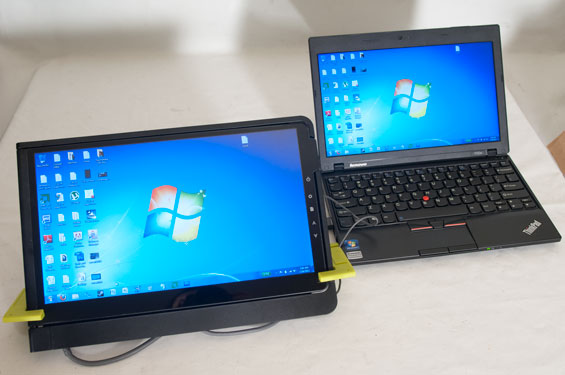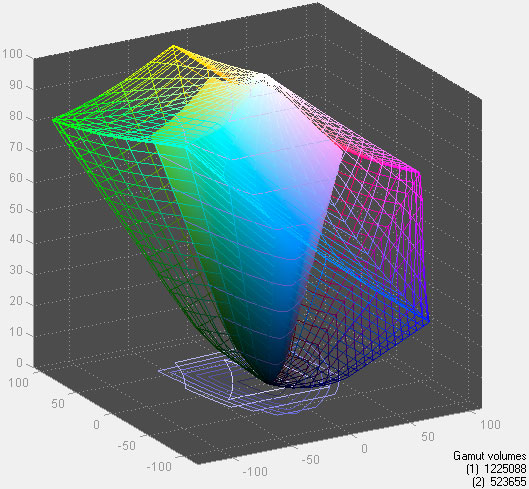Capsule Review: GeChic's On-Lap 1301 Laptop Monitor
by Dustin Sklavos on January 19, 2012 2:16 AM EST- Posted in
- Laptops
- Peripherals
- LCD
- gechic
Performance and Screen Quality
The GeChic On-Lap 1301 is a 13” screen being powered off of USB, and as a result it’s not exactly going to be a big winner on any technical merits. On NewEgg, GeChic rates the 1301’s brightness at 200 nits and the contrast ratio at 500:1, and just like the big boys they cheerfully exaggerate the screen’s capabilities. Thankfully they’re honest about color quality; because it’s a TN panel it only produces 262,000 colors. Viewing angles are in the doghouse, too, but given the size and orientation the On-Lap is expected to be used in, that’s not a major strike against it.

What does strike against the On-Lap 1301 is the use of a glossy finish instead of a matte. Understanding that gloss is fairly typical of consumer-oriented products, the On-Lap suffers mightily for its finish due partly because its “closed” position still leaves the screen exposed. Glossy screens show dirt far more easily than their matte counterparts. Worse still, that means the screen is left essentially unprotected. Given that pressing the control buttons on the back of the screen results in ripples in the display, it stands to reason the screen is neither well-reinforced nor well-protected, making its value as a travel accessory suddenly much more questionable. While the frame feels durable enough, I’d be concerned about the safety of the screen itself, especially when it’s retailing for $200.

So how does it actually rate in terms of raw performance? The On-Lap 1301 sports a maximum brightness of 142 nits, but default brightness is just 94, both well shy of the rated 200 nits. With default black levels at 0.7 nits, that works out to a contrast ratio of 134:1, again well below what GeChic rates it at. Delta-E is no better at 2.53 on average, but color gamut at least is 42.7% of AdobeRGB 1998. Outside of the low brightness (a byproduct of being powered solely off USB), you could easily mistake the On-Lap for another laptop display. That’s good news for matching it up with notebooks on the market, but also speaks to the generally dire state of notebook displays. Still, we can’t complain too much since the On-Lap doesn’t actually require an external power source and can thus be used on the battery.
And how does it handle on the battery? The display is after all typically one of the most, if not the single most power hungry part of a notebook, so we tested it on the Acer TravelMate 8481T we reviewed recently using our internet battery test. The 8481T, without powering the GeChic display, is able to run for 8:41—that’s eight hours and 41 minutes, no mean feat. Plug in the display and running time drops to 5:55. That means if you use the GeChic On-Lap, you can expect your battery running time to drop by roughly a third assuming you’re using it with a similarly-sized notebook with a similar display. Honestly that doesn’t seem so bad given that you’re driving an entire second screen.
















31 Comments
View All Comments
PhoenixEnigma - Saturday, January 21, 2012 - link
Would be neat to stick to the side of a LAN party box, too. You could certainly do better for the price display-wise, but the convenience is second to none, and it would look neat on the side of a SFF PC.Nihility - Saturday, January 21, 2012 - link
I'm worried that adding 2 pounds of weight to the already flimsy hinges of a laptop would damage it over time.Especially because that weight is added at an angle creating a lot of torque.
Out of Box Experience - Sunday, January 22, 2012 - link
Normal USB monitors cannot output a display untill the USB drivers loadBut THIS could be used as a portable diagnostic monitor when you are unsure if you have a computer problem or a monitor problem
ANY 5 volt X 1 Amp USB power supply (Battery or AC) could power the monitor and the you would get instant display capeability for accessing BIOS screens before the USB drivers kick in
Portable, Extremely Low Power, Instant On.....
Whats not to like?
CZroe - Sunday, January 22, 2012 - link
Back when LCD desktop monitors were uncommon but larger LCD panels were common in notebooks, I was angry that no notebooks have VGA or DVI input, especially considering that they were the most expensive part in a notebook by far and they could help justify the cost. I remember it being a lot of trouble to troubleshoot someone's computer if I needed to try another monitor and I only brought my laptop and some tools (who's going to pack up a CRT unless they know it's needed ahead of time?).I still wonder why no one has yet done this.
eh_ch - Friday, February 3, 2012 - link
+1FXi - Sunday, January 22, 2012 - link
It would cost peanuts for any of the giants, Samsung or LG to offer screens of this nature. I won't be surprised if this market gets a bunch of additional competitors since laptops are more than 50% of the market and growing.Finraziel - Monday, January 23, 2012 - link
I was actually searching for something like this a while ago, though not for it being portable... What I was trying to find was a compact monitor for use at home in the living room, to use the HTPC when the TV was in use by someone else, that could easily be stowed away when not in use. Since I'd also want to play games on it from time to time, all of those USB monitors can't be used, but this would be quite interesting.7Enigma - Monday, January 23, 2012 - link
You could run off a single one if mobile (along with the negatives of brightness/etc.) but if connected by AC you could plug in the second for additional brightness.Honestly I would see this product used MORE when connected to the mains rather than on battery alone. Bump up the resolution, give the ability to run with more power, fix the hinge issues you've brought up and this could be a really great product for the mobile workstation crew that doesn't want to lug along a standalone monitor.
Out of Box Experience - Monday, January 23, 2012 - link
I respectfully disagree to a certain degree (HUH?)A 1080P monitor could be used when AC is connected, but when on battery, the monitor could limit the Display Area AND resolution to keep the power requirements down when you need a mobile monitor
A physical switch could also allow you to run at 1080P when you have enough battery power to use it for extended periods of time
Out of Box Experience - Monday, January 23, 2012 - link
Tablets "could" also be used for portable diagnostic screens by adding a micro HDMI or Displayport input but I doubt we will see them if we haven't yetA tablet would have its own power supply as well and you would only need a micro HDMI to VGA / DVI / HDMI or DISPLAYPORT cable
But then again, why couldn't we use a portable digital TV or a portable digital photo frame or digital media player to do the same thing
Probably so we need to buy 20 separate devices instead of 1 device that does it all
MONEY MONEY MONEY